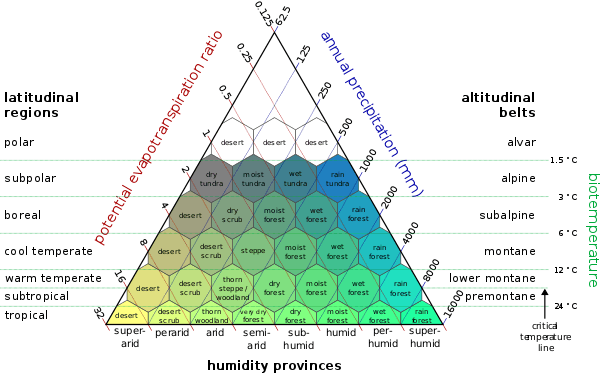Holdridge life zones
The Holdridge life zones system is a global bioclimatic scheme for the classification of land areas. It was first published by Leslie Holdridge in 1947, and updated in 1967. It is a relatively simple system based on few empirical data, giving objective mapping criteria.[1] A basic assumption of the system is that both soil and climax vegetation can be mapped once the climate is known.[2]

Scheme
While it was first designed for tropical and subtropical areas, the system applies globally. The system has been shown to fit tropical vegetation zones, Mediterranean zones, and boreal zones, but is less applicable to cold oceanic or cold arid climates where moisture becomes the determining factor. The system has found a major use in assessing the possible changes in natural vegetation patterns due to global warming.[3]
The three axes of the barycentric subdivisions are:
- precipitation (annual, logarithmic)
- biotemperature (mean annual, logarithmic)
- potential evapotranspiration ratio (PET) to mean total annual precipitation.
Further indicators incorporated into the system are:
- humidity provinces
- latitudinal regions
- altitudinal belts
Biotemperature is based on the growing season length and temperature. It is measured as the mean of all temperatures, with all temperatures below freezing and above 30 °C adjusted to 0 °C,[4] as plants are dormant at these temperatures. Holdridge's system uses biotemperature first, rather than the temperate latitude bias of Merriam's life zones, and does not primarily consider elevation. The system is considered more appropriate to the complexities of tropical vegetation than Merriam's system.
Scientific relationship between the 3 axes and 3 indicators
Potential evapotranspiration (PET) is the amount of water that would be evaporated and transpired if there were sufficient water available. High temperatures result in higher PET. Evapotranspiration (ET) is the sum of evaporation and plant transpiration from the Earth's land surface to atmosphere. Evapotranspiration can never be greater than PET. The ratio, Precipitation/PET, is the aridity index (AI), with an AI<0.2 indicating arid/hyperarid, and AI<0.5 indicating dry.
Coldest
/\
/ \
PET - -- - Rain
Coldest regions have not much evapotranspiration nor precipitation, hence polar deserts. In the warmer regions, there are deserts with maximum PET but low rainfall that make the soil even drier, and rain forests with low PET and maximum rainfall causing river systems to drain excess water into oceans.
Classes
The classes defined within the system, as used by the International Institute for Applied Systems Analysis (IIASA), are:
- Polar desert
- Subpolar dry tundra
- Subpolar moist tundra
- Subpolar wet tundra
- Subpolar rain tundra
- Boreal desert
- Boreal dry scrub
- Boreal moist forest
- Boreal wet forest
- Boreal rain forest
- Cool temperate desert
- Cool temperate desert scrub
- Cool temperate steppe
- Cool temperate moist forest
- Cool temperate wet forest
- Cool temperate rain forest
- Warm temperate desert
- Warm temperate desert scrub
- Warm temperate thorn scrub
- Warm temperate dry forest
- Warm temperate moist forest
- Warm temperate wet forest
- Warm temperate rain forest
- Subtropical desert
- Subtropical desert scrub
- Subtropical thorn woodland
- Subtropical dry forest
- Subtropical moist forest
- Subtropical wet forest
- Subtropical rain forest
- Tropical desert
- Tropical desert scrub
- Tropical thorn woodland
- Tropical very dry forest
- Tropical dry forest
- Tropical moist forest
- Tropical wet forest
- Tropical rain forest
See also
References
- US EPA, OA (January 29, 2013). "About the National Health and Environmental Effects Research Laboratory (NHEERL)". US EPA. Archived from the original on February 12, 2013.
- Harris SA (1973). "Comments on the Application of the Holdridge System for Classification of World Life Zones as Applied to Costa Rica". Arctic and Alpine Research. 5 (3): A187–A191. JSTOR 1550169.
- Leemans, Rik (1990). "Possible Changes in Natural Vegetation Patterns Due to a Global Warming". National Geophysical Data Center (NOAA). Archived from the original on 2009-10-16.
- Lugo, A. E. (1999). "The Holdridge life zones of the conterminous United States in relation to ecosystem mapping". Journal of Biogeography. 26 (5): 1025–1038. doi:10.1046/j.1365-2699.1999.00329.x. Archived (PDF) from the original on 27 May 2015. Retrieved 27 May 2015.